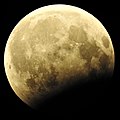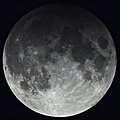References
- ↑ "NASA - Index to Five Millennium Catalog of Lunar Eclipses". eclipse.gsfc.nasa.gov. Retrieved 18 September 2020.
- ↑ "Catalog of Lunar Eclipses: -1999 to -1900". eclipse.gsfc.nasa.gov. Retrieved 18 September 2020.
- ↑ "Catalog of Lunar Eclipses: -1899 to -1800". eclipse.gsfc.nasa.gov. Retrieved 18 September 2020.
- ↑ "Catalog of Lunar Eclipses: -1799 to -1700". eclipse.gsfc.nasa.gov. Retrieved 18 September 2020.
- ↑ "Catalog of Lunar Eclipses: -1699 to -1600". eclipse.gsfc.nasa.gov. Retrieved 18 September 2020.
- ↑ "Catalog of Lunar Eclipses: -1599 to -1500". eclipse.gsfc.nasa.gov. Retrieved 18 September 2020.
- ↑ "Catalog of Lunar Eclipses: -1499 to -1400". eclipse.gsfc.nasa.gov. Retrieved 18 September 2020.
- ↑ "Catalog of Lunar Eclipses: -1399 to -1300". eclipse.gsfc.nasa.gov. Retrieved 18 September 2020.
- ↑ "Catalog of Lunar Eclipses: -1299 to -1200". eclipse.gsfc.nasa.gov. Retrieved 18 September 2020.
- ↑ "Catalog of Lunar Eclipses: -1199 to -1100". eclipse.gsfc.nasa.gov. Retrieved 18 September 2020.
- ↑ "Catalog of Lunar Eclipses: -1099 to -1000". eclipse.gsfc.nasa.gov. Retrieved 18 September 2020.
- ↑ "Catalog of Lunar Eclipses: -0999 to -0900". eclipse.gsfc.nasa.gov. Retrieved 18 September 2020.
- ↑ "Catalog of Lunar Eclipses: -0899 to -0800". eclipse.gsfc.nasa.gov. Retrieved 18 September 2020.
- ↑ "Catalog of Lunar Eclipses: -0799 to -0700". eclipse.gsfc.nasa.gov. Retrieved 18 September 2020.
- ↑ "Catalog of Lunar Eclipses: -0699 to -0600". eclipse.gsfc.nasa.gov. Retrieved 18 September 2020.
- ↑ "Catalog of Lunar Eclipses: -0599 to -0500". eclipse.gsfc.nasa.gov. Retrieved 18 September 2020.
- ↑ "Catalog of Lunar Eclipses: -0499 to -0400". eclipse.gsfc.nasa.gov. Retrieved 18 September 2020.
- ↑ "Catalog of Lunar Eclipses: -0399 to -0300". eclipse.gsfc.nasa.gov. Retrieved 18 September 2020.
- ↑ "Catalog of Lunar Eclipses: -0299 to -0200". eclipse.gsfc.nasa.gov. Retrieved 18 September 2020.
- ↑ "Catalog of Lunar Eclipses: -0199 to -0100". eclipse.gsfc.nasa.gov. Retrieved 18 September 2020.
- ↑ "Catalog of Lunar Eclipses: -0099 to 0000". eclipse.gsfc.nasa.gov. Retrieved 18 September 2020.
- ↑ "Catalog of Lunar Eclipses: 0001 to 0100". eclipse.gsfc.nasa.gov. Retrieved 18 September 2020.
- ↑ "Catalog of Lunar Eclipses: 0101 to 0200". eclipse.gsfc.nasa.gov. Retrieved 18 September 2020.
- ↑ "Catalog of Lunar Eclipses: 0201 to 0300". eclipse.gsfc.nasa.gov. Retrieved 18 September 2020.
- ↑ "Catalog of Lunar Eclipses: 0301 to 0400". eclipse.gsfc.nasa.gov. Retrieved 18 September 2020.
- ↑ "Catalog of Lunar Eclipses: 0401 to 0500". eclipse.gsfc.nasa.gov. Retrieved 18 September 2020.
- ↑ "Catalog of Lunar Eclipses: 0501 to 0600". eclipse.gsfc.nasa.gov. Retrieved 18 September 2020.
- ↑ "Catalog of Lunar Eclipses: 0601 to 0700". eclipse.gsfc.nasa.gov. Retrieved 18 September 2020.
- ↑ "Catalog of Lunar Eclipses: 0701 to 0800". eclipse.gsfc.nasa.gov. Retrieved 18 September 2020.
- ↑ "Catalog of Lunar Eclipses: 0801 to 0900". eclipse.gsfc.nasa.gov. Retrieved 18 September 2020.
- ↑ "Catalog of Lunar Eclipses: 0901 to 1000". eclipse.gsfc.nasa.gov. Retrieved 18 September 2020.
- ↑ "Catalog of Lunar Eclipses: 1001 to 1100". eclipse.gsfc.nasa.gov. Retrieved 18 September 2020.
- ↑ "Catalog of Lunar Eclipses: 1101 to 1200". eclipse.gsfc.nasa.gov. Retrieved 18 September 2020.
- ↑ "Catalog of Lunar Eclipses: 1201 to 1300". eclipse.gsfc.nasa.gov. Retrieved 18 September 2020.
- ↑ "Catalog of Lunar Eclipses: 1301 to 1400". eclipse.gsfc.nasa.gov. Retrieved 18 September 2020.
- ↑ "Catalog of Lunar Eclipses: 1401 to 1500". eclipse.gsfc.nasa.gov. Retrieved 18 September 2020.
- ↑ "Catalog of Lunar Eclipses: 1501 to 1600". eclipse.gsfc.nasa.gov. Retrieved 18 September 2020.
- ↑ "Catalog of Lunar Eclipses: 1601 to 1700". eclipse.gsfc.nasa.gov. Retrieved 18 September 2020.
- ↑ "Catalog of Lunar Eclipses: 1701 to 1800". eclipse.gsfc.nasa.gov. Retrieved 18 September 2020.
- ↑ "Catalog of Lunar Eclipses: 1801 to 1900". eclipse.gsfc.nasa.gov. Retrieved 18 September 2020.
- ↑ "Catalog of Lunar Eclipses: 1901 to 2000". eclipse.gsfc.nasa.gov. Retrieved 18 September 2020.
- ↑ "Catalog of Lunar Eclipses: 2001 to 2100". eclipse.gsfc.nasa.gov. Retrieved 18 September 2020.
- ↑ "Catalog of Lunar Eclipses: 2101 to 2200". eclipse.gsfc.nasa.gov. Retrieved 18 September 2020.
- ↑ "Catalog of Lunar Eclipses: 2201 to 2300". eclipse.gsfc.nasa.gov. Retrieved 18 September 2020.
- ↑ "Catalog of Lunar Eclipses: 2301 to 2400". eclipse.gsfc.nasa.gov. Retrieved 18 September 2020.
- ↑ "Catalog of Lunar Eclipses: 2401 to 2500". eclipse.gsfc.nasa.gov. Retrieved 18 September 2020.
- ↑ "Catalog of Lunar Eclipses: 2501 to 2600". eclipse.gsfc.nasa.gov. Retrieved 18 September 2020.
- ↑ "Catalog of Lunar Eclipses: 2601 to 2700". eclipse.gsfc.nasa.gov. Retrieved 18 September 2020.
- ↑ "Catalog of Lunar Eclipses: 2701 to 2800". eclipse.gsfc.nasa.gov. Retrieved 18 September 2020.
- ↑ "Catalog of Lunar Eclipses: 2801 to 2900". eclipse.gsfc.nasa.gov. Retrieved 18 September 2020.
- ↑ "Catalog of Lunar Eclipses: 2901 to 3000". eclipse.gsfc.nasa.gov. Retrieved 18 September 2020.


